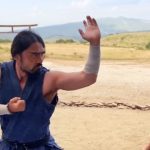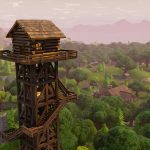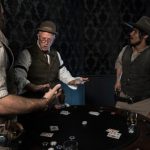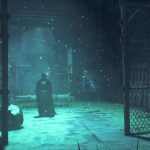Assassin’s Creed A to Z Guide
Assassin’s Creed A to Z Guide
Spanning more than 20 games and extending its reach across books, comics, and soon a major motion picture on December 21, the Assassin’s Creed series has built a staggering amount of lore around the millennia-long secret war between Assassins and Templars. With new heroes, villains, and revelations about the distant past introduced every year, it’s a lot to take in – so we’ve assembled a quick A-to-Z primer on some of the standout people, places, and events that have shaped the series over the years, starting with…
[A] [B] [C] [D] [E] [F] [G] [H] [I] [J] [K] [L] [M] [N] [O] [P] [Q] [R] [S] [T] [U] [V] [W] [X] [Y] [Z]
A for Assassin Brotherhood

The secret society at the center of every Assassin’s Creed game, the hooded Assassins have fought since time immemorial to protect human freedom from the insidious machinations of the Templars, who strive for absolute control. While their real, historical inspiration was a religious order that operated in the Levant during the Crusades, these Assassins have been active for much longer, tracing their origins to the mysterious First Civilization. Along with the Templars, they’ve had a hand in nearly every significant event in human history.
B for Borgia

One of the most infamous families of the Renaissance, the Borgias were the archenemies of Ezio Auditore da Firenze in Assassin’s Creed II and Assassin’s Creed Brotherhood. Patriarch Rodrigo Borgia (also known as Alexander VI, widely remembered as history’s most corrupt Pope) was at the center of a Templar conspiracy that executed male members of Ezio’s family on false charges, and his wildly ambitious son, Cesare, seized the role of central villain when he invaded the Assassin stronghold of Monteriggioni at the beginning of Assassin’s Creed Brotherhood.
C for Connor

A half-English, half-Mohawk Assassin, the earnest Connor (aka Ratonhnhaké:ton) revitalized and rebuilt the American Brotherhood during the Revolutionary War, fighting alongside Washington against both the English and the schemes of his Templar father, Haytham.
D for Dorian

Arno Dorian’s life was shaped by Assassin-Templar fighting and reconciliation. The son of an Assassin, he saw his father murdered by Assassin-turned-Templar Shay Cormac, and was raised by the Templar Grand Master of Paris, François de la Serre. After de la Serre’s was murdered by underlings, Arno joined the Assassins to seek revenge, while at the same time romancing and working alongside Templar heiress Elise de la Serre.
E for Ezio Auditore

The best-known Assassin of the series (and the only one to get a whole trilogy to himself), Ezio Auditore’s cocky charm led players through a three-game arc of revenge, love, conquest, and discovery, giving them the chance to experience Renaissance Italy through his eyes.Beginning as a headstrong teenager whose father and brothers were unjustly executed, we watched him grow into a Master Assassin as he uncovered a conspiracy that led to the highest echelons of power, became the de facto landlord or Rome, and was the conduit for our first real glimpse of the First Civilization.
F for Frye

Evie and Jacob Frye were a pair of renegade Assassin twins who operated in Victorian London, uniting the city’s street gangs to disrupt Templar control. Aided by bold technological advances (many of which they incorporated into their Assassin Gauntlets) and the guidance of Henry Green (aka Jayadeep Mir, son of legendary Kashmiri Assassin Arbaaz Mir), they brawled and sneaked their way across London, liberating the city district by district. The Frye name is also noteworthy for the actions of Jacob’s granddaughter Lydia, who hunted German spies for Winston Churchill during World War I.
G for Grandpré

Operating in New Orleans in the years before the American Revolution, Aveline de Grandpré was the daughter of a French merchant and an African slave. Investigating the disappearance of slaves from around the city, she uncovered a Templar conspiracy to excavate First Civilization artifacts from Chichen Itza, and eventually assassinated her way through the ranks of Templars to uncover the identity of the mysterious “Company Man.”
H for Hidden Blade

Every Assassin’s signature weapon. Hidden Blades have gone through a lot of changes over the years, beginning as simple retractable knives attached to leather cuffs, and eventually becoming fearsome multipurpose weapons that hid poison darts, miniature firearms, folding crossbows, rope launchers, and more. Each Assassin has brought their own innovations to the Hidden Blade, making them an extension of each protagonist’s personality as well as a vital tool.
I for Ibn La’Ahad

Arabic for “Son of No One,” this was the surname of Altaïr Ibn La’Ahad, protagonist of the first Assassin’s Creed. While the first game saw him transform from an arrogant loner into an idealistic team player, Altaïr quickly became much more, using knowledge gained from the Apple of Eden to reform and reshape his order. The new practices and technologies he put into place enabled the Assassins to survive their apparent defeat at the hands of the Mongols, eventually spreading their philosophy across the world.
J for Juno

A member of the mysterious Precursor race, Juno was one of three scientists (the other two being Jupiter and Minerva) tasked with saving their First Civilization from what would come to be known as the Toba catastrophe of 75,000 BCE. Instead, Juno planned to subvert the solution to conquer the world, leading her colleagues to imprison her disembodied consciousness for millennia. Freed in 2012 by Desmond Miles, she now lurks in the world’s computer networks, allying with Templars to work toward her imminent reincarnation.
K for Kenway

At one point a prominent Assassin family, the Kenways first became associated with the order when the pirate Edward Kenway stole the identity of an Assassin traitor named Duncan Walpole. Eventually accepted into the Assassin Brotherhood, Edward foiled the plans of the Sage, a human-despising, frequently reincarnated man with the personality and memories of Juno’s late husband, Aita. Edward was eventually betrayed and killed by a secret Templar agent, who then groomed Edward’s son Haytham (father of Connor) to join the Templars.
L for Leonardo da Vinci

One of the most famous polymaths of all time, Leonardo was an accomplished artist, scientist, and engineer. In the Assassin’s Creed universe, he was also a lifelong friend of Ezio Auditore, for whom he created new gadgets as well as improving old ones.
M for Miles

Desmond Miles was the modern-day protagonist of the first five Assassin’s Creed games, experiencing the genetic memories of Altaïr, Ezio, and Connor through a device known as the Animus. Raised in an Assassin compound, he ran away to become a bartender in New York, at which point the Templars kidnapped him for use as an Animus test subject.
N for New York City

The Big Apple plays a significant role in the Assassin’s Creed series, particularly in Assassin’s Creed III and Assassin’s Creed Rogue. Not only is the 18th century version of the city a major setting in both of those games, but it’s near the Grand Temple, a massive Precursor vault that houses the means to avert a global catastrophe – as well as the restless “spirit” of Juno.
O for Otso Berg

The Templars’ loyal attack dog, Juhani Otso Berg leads Sigma Team, a special Abstergo Industries task force formed to hunt Assassins. Debuting as the series’ first playable Templar in the multiplayer segments of Assassin’s Creed Revelations, Berg is a ruthless commando who later appeared as an ominous taskmaster in Assassin’s Creed Rogue, and as a central villain in the modern-day portions of Assassin’s Creed Syndicate.
P for Precursors

Also known as the First Civilization or the Isu, the Precursors are a long-extinct species who possessed a sixth sense, triple-helix DNA, and technology far beyond human comprehension. The basis for most ancient myths, the Precursors created humanity as a genetically engineered slave race, only to lose control over their thralls when two humans – Adam and Eve – used a so-called Apple of Eden (actually a mind-control device) to awaken humans to reality. The resulting war between the two races was cut short by the Toba catastrophe (or First Disaster), which annihilated the First Civilization and led to the gradual extinction of the Isu. All that remains of them now are traces of their DNA in humans, and their seemingly magical artifacts, known as Pieces of Eden.
Q for Quakes

The Precursors left behind a lot of artifacts, with a variety of uses. One of those uses was to seismically stabilize certain parts of the Earth, which Shay Cormac learned the hard way when he removed a stabilizing artifact from a temple underneath Lisbon, Portugal, thinking it to be an Apple of Eden. The resulting quake left thousands dead. Given that a similar quake had happened years earlier in Haiti, again through Assassin meddling, the incident shook Shay’s faith in the order and pushed him to defect to the Templars.
R for Rikkin

Played by Jeremy Irons in the Assassin’s Creed movie, Alan Rikkin is a top-ranking Templar and the CEO of the order’s public front, Abstergo Industries. Responsible for responding to Abstergo media coverage and leading the search for Pieces of Eden (among other things), he was an imposing, mostly off-screen presence in the first Assassin’s Creed and has since become one of the series’ most sinister behind-the-scenes figures.
S for Shay Cormac

Operating around New York in the years before the American Revolution, Shay Patrick Cormac was a turncoat Irish Assassin who defected to the Templars after one of his missions triggered a massive earthquake in Portugal. Believing the Assassins to be willfully blind to danger, he dedicated his life to hunting them, reducing the Colonial Brotherhood to almost nothing by the time he was through.
T for Templar

The other secret society at the heart of Assassin’s Creed, the Templar Order is fixated on achieving total control over humanity, imposing order through political and corporate scheming, as well as by using Pieces of Eden to manipulate people and wield influence. The menacing yin to the Assassins’ idealistic yang, the Templars have struggled against their hooded nemeses for millennia – and like the Assassins, they came out of the shadows briefly during the Crusades, when they were known as the Knights Templar.
U for Uberto Alberti

Florence’s heavyset Gonfaloniere (roughly equivalent to a sheriff) was a close friend and ally of the Auditore family – or so it seemed. In truth, Uberto Alberti was a Templar agent who, in order to preserve his own family, betrayed the Auditore and hanged Ezio’s father and brothers on false charges. Consequently, he was Ezio’s first real target, kicking off a trilogy of vendettas and assassinations.
V for Vidic

As a member of the Templars’ central governing body, the Inner Sanctum, Dr. Warren Vidic led Abstergo’s genetic research, using the Animus to search for memories related to Pieces of Eden. He was also a central villain in early Assassin’s Creed games, imprisoning Desmond Miles, chasing him from his hiding places, and building an army of elite, Animus-trained operatives to hunt him down, all while striving to create a satellite – the Eye – that could project Templar influence across the world.
W for Washington

The first President of the United States, George Washington played a prominent role in Assassin’s Creed III, maintaining an uneasy alliance with Connor during the Revolution. That alliance was tested further during the events of The Tyranny of King Washington, when an Apple of Eden created an alternate reality in which a power-mad Washington became absolute dictator of America.
X for Xerxes I

While he doesn’t appear in the Assassin’s Creed games, Persia’s Xerxes I – yes, that Xerxes I, the one who fought the Spartans – is noted in Assassin’s Creed II as having been the first known person to be assassinated with a Hidden Blade. His killer, the Assassin Darius, was honored with a statue in the sanctuary under the Villa Auditore, Ezio’s ancestral home, in Monteriggioni.
Y for Yusuf Tazim

Leader of the Ottoman Assassins in Constantinople, Yusuf Tazim stepped in to support Ezio while the elder Assassin was separated from his familiar Italian Brotherhood. Teaching Ezio to craft bombs and to use a new addition to the Hidden Blade – the hookblade – for combat and zipline-riding, Yusuf’s guidance was invaluable in adapting to Constantinople and the unique rhythms of Assassin’s Creed Revelations.
Z for Zaragoza

In 1491 – roughly the same era as the Assassin’s Creed movie’s historical segments – Zaragoza was among the Spanish cities visited by Ezio Auditore when he was sent to protect a navigator named Christoffa from Templar assassination. While there, Ezio infiltrated an Inquisition prison and worked frantically to free captured members of the Spanish Assassin Brotherhood, who had been rounded up and awaited trial as heretics.
[A] [B] [C] [D] [E] [F] [G] [H] [I] [J] [K] [L] [M] [N] [O] [P] [Q] [R] [S] [T] [U] [V] [W] [X] [Y] [Z]
The post Assassin’s Creed A to Z Guide appeared first on UbiBlog – Ubisoft®.
(76)














